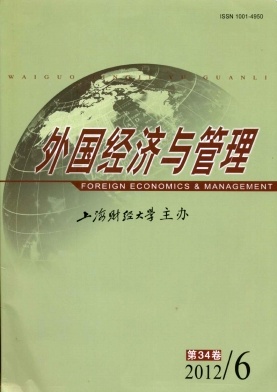价值共创理论形成路径探析与未来研究展望
外国经济与管理 2012 年 第 34 卷第 06 期, 页码:66 - 73
摘要
参考文献
摘要
在文献梳理的基础上,本文首先介绍了生产者单独、生产者与消费者共同以及消费者单独三种不同的价值创造方式;然后对近几年刚刚形成的价值共创理论的演进脉络进行了梳理,着重介绍了Prahalad和Ramaswamy从企业竞争和战略管理视角提出的基于消费者体验的价值共创理论以及Var-go和Lusch提出的基于服务主导逻辑的价值共创理论,并且对这两种价值共创理论进行了比较分析;再后提出并阐述了生产者逻辑和消费者逻辑这两种不同的价值共创逻辑,构建了基于生产者逻辑和消费者逻辑的价值共创过程模型;最后在分析现有研究不足的基础上对未来相关研究进行了展望。
[1]Auh S,et al.Co-production and customer loyalty in financial services[J].Journal of Retailing,2007,83(3):359-370.
[2]Becker G S.A theory of the allocation of time[J].Economic Journal,1965,75(2):493-517.
[3]Chan K W,et al.Is customer participation in value creation a double-edged sword?Evidence from professional financial services across cultures[J].Journal of Marketing,2010,74(3):48-64.
[4]Cova B and Salle R.Co-creating value with customer network actors[J].Industrial Marketing Management,2008,37(3):270-277.
[5]Doorn V J,et al.Customer engagement behavior:Theoretical foundations and research directions[J].Journal of Service Re-search,2010,13(3):253-266.
[6]Etgar M A.Descriptive model of the consumer co-production process[J].Journal of the Academy of Marketing Science,2008,36(1):97-108.
[7]Fang E.Customer participation and the trade-off between new product innovativeness and speed to market[J].Journal of Marketing,2008,72(Jul.):90-104.
[8]Fuchs V.The service economy[M].New York:Columbia Uni-versity Press,1968.
[9]Grnroos C.Service management and marketing:A customer relationship management approach[M].Chichester:John Wi-ley&Sons,2000.
[10]Grnroos C.Service logic revisited:Who creates value?And who co-creates?[J].European Business Review,2008,20(4):298-314.
[11]Grnroos C.Towards service logical:The unique contribution of value co-creation[R].Hanken School of Economics Work-ing Paper,2009.
[12]Heinonen K,et al.A customer-dominant logic of service[J].Journal of Service Management,2010,21(4):531-548.
[13]Hoyer W D,et al.Consumer cocreation in new product deve-lopment[J].Journal of Service Research,2010,13(3):283-296.
[14]Jaworski B and Kohli A K.Co-creating the voice of the cus-tomer[A].Lusch R F and Vargo S L(Eds.).The service do-mi-nant logic of marketing:Dialog,debate and directions[C].Armonk,NY:M E Sharpe,2006.
[15]Kalaignanam K and Varadarajan R.Customers as coproducers:Implications for marketing strategy effectiveness and marketing operations efficiency[A].Lusch R F and Vargo S L(Eds.).The service dominant logic of marketing:Dialog,debate and directions[C].Armonk,NY:M E Sharpe,2006.
[16]Kelley S,et al.Organizational socialization of service customers[J].Journal of Business Research,1992,25(3):197-214.
[17]Meuter M L,et al.Choosing among alternative service deli-very modes:An investigation of customer trial of self-service technologies[J].Journal of Marketing,2005,69(4):61-83.
[18]Nambisan S and Baron R A.Virtual customer environments:Testing a model of voluntary participation in value co-crea-tion activities[J].Journal of Product Innovation Manage-ment,2009,26(4):388-406.
[19]O’Hern M S and Rindfleisch A.Customer co-creation:A ty-pology and research agenda[J].Review of Marketing Re-search,2009,6(1):84-106.
[20]Payne A F,et al.Managing the co-creation of value[J].Jour-nal of the Academy Marketing Science,2008,36(1):83-96.
[21]Prahalad C K and Ramaswamy V.Co-creation experiences:The next practice in value creation[J].Journal of Interactive Marketing,2004,3(1):5-14
[22]Prahalad C K and Ramaswamy V.Co-opting customer com-petence[J].Harvard Business Review,2000,78(1):79-87.
[23]Ramirez R.Value co-production:Intellectual origins and im-plications for practice and research[J].Strategic Management Journal,1999,20(1):49-65.
[24]Schau H J,et al.How brand community practices create value[J].Journal of Marketing,2009,73(5):30-51.
[25]Sheth J N,et al.The antecedents and consequences of cus-tomer-centric marketing[J].Journal of the Academy of Mar-keting Science,2000,28(1):55-66.
[26]Vargo S L and Lusch R F.Evolving to a new dominant logic for Marketing[J].Journal of Marketing,2004,68(1):1-17.
[27]Vargo S L and Lusch R F.Service-dominant logic:Continuing the evolution[J].Journal of the Academy of Marketing Science,2008,36(1):1-10.
[28]Vargo S L,et al.On value and value co-creation:A service systems and service logic perspective[J].European Manage-ment Journal,2008,26(3):145-152.
[2]Becker G S.A theory of the allocation of time[J].Economic Journal,1965,75(2):493-517.
[3]Chan K W,et al.Is customer participation in value creation a double-edged sword?Evidence from professional financial services across cultures[J].Journal of Marketing,2010,74(3):48-64.
[4]Cova B and Salle R.Co-creating value with customer network actors[J].Industrial Marketing Management,2008,37(3):270-277.
[5]Doorn V J,et al.Customer engagement behavior:Theoretical foundations and research directions[J].Journal of Service Re-search,2010,13(3):253-266.
[6]Etgar M A.Descriptive model of the consumer co-production process[J].Journal of the Academy of Marketing Science,2008,36(1):97-108.
[7]Fang E.Customer participation and the trade-off between new product innovativeness and speed to market[J].Journal of Marketing,2008,72(Jul.):90-104.
[8]Fuchs V.The service economy[M].New York:Columbia Uni-versity Press,1968.
[9]Grnroos C.Service management and marketing:A customer relationship management approach[M].Chichester:John Wi-ley&Sons,2000.
[10]Grnroos C.Service logic revisited:Who creates value?And who co-creates?[J].European Business Review,2008,20(4):298-314.
[11]Grnroos C.Towards service logical:The unique contribution of value co-creation[R].Hanken School of Economics Work-ing Paper,2009.
[12]Heinonen K,et al.A customer-dominant logic of service[J].Journal of Service Management,2010,21(4):531-548.
[13]Hoyer W D,et al.Consumer cocreation in new product deve-lopment[J].Journal of Service Research,2010,13(3):283-296.
[14]Jaworski B and Kohli A K.Co-creating the voice of the cus-tomer[A].Lusch R F and Vargo S L(Eds.).The service do-mi-nant logic of marketing:Dialog,debate and directions[C].Armonk,NY:M E Sharpe,2006.
[15]Kalaignanam K and Varadarajan R.Customers as coproducers:Implications for marketing strategy effectiveness and marketing operations efficiency[A].Lusch R F and Vargo S L(Eds.).The service dominant logic of marketing:Dialog,debate and directions[C].Armonk,NY:M E Sharpe,2006.
[16]Kelley S,et al.Organizational socialization of service customers[J].Journal of Business Research,1992,25(3):197-214.
[17]Meuter M L,et al.Choosing among alternative service deli-very modes:An investigation of customer trial of self-service technologies[J].Journal of Marketing,2005,69(4):61-83.
[18]Nambisan S and Baron R A.Virtual customer environments:Testing a model of voluntary participation in value co-crea-tion activities[J].Journal of Product Innovation Manage-ment,2009,26(4):388-406.
[19]O’Hern M S and Rindfleisch A.Customer co-creation:A ty-pology and research agenda[J].Review of Marketing Re-search,2009,6(1):84-106.
[20]Payne A F,et al.Managing the co-creation of value[J].Jour-nal of the Academy Marketing Science,2008,36(1):83-96.
[21]Prahalad C K and Ramaswamy V.Co-creation experiences:The next practice in value creation[J].Journal of Interactive Marketing,2004,3(1):5-14
[22]Prahalad C K and Ramaswamy V.Co-opting customer com-petence[J].Harvard Business Review,2000,78(1):79-87.
[23]Ramirez R.Value co-production:Intellectual origins and im-plications for practice and research[J].Strategic Management Journal,1999,20(1):49-65.
[24]Schau H J,et al.How brand community practices create value[J].Journal of Marketing,2009,73(5):30-51.
[25]Sheth J N,et al.The antecedents and consequences of cus-tomer-centric marketing[J].Journal of the Academy of Mar-keting Science,2000,28(1):55-66.
[26]Vargo S L and Lusch R F.Evolving to a new dominant logic for Marketing[J].Journal of Marketing,2004,68(1):1-17.
[27]Vargo S L and Lusch R F.Service-dominant logic:Continuing the evolution[J].Journal of the Academy of Marketing Science,2008,36(1):1-10.
[28]Vargo S L,et al.On value and value co-creation:A service systems and service logic perspective[J].European Manage-ment Journal,2008,26(3):145-152.
引用本文
武文珍, 陈启杰. 价值共创理论形成路径探析与未来研究展望[J]. 外国经济与管理, 2012, 34(6): 66–73.
导出参考文献,格式为:
下一篇:架构理论研究脉络梳理与未来展望





 9998
9998  941
941

